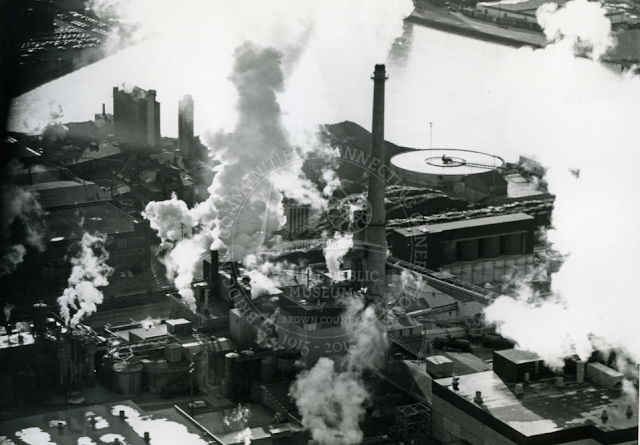G-P Day: (Satellite) Was Northern Papers, which was started in 1901 and produced "Sanitary Tissue."
G-P Mason: (Satellite) Was closed in 2019-20.
G-P Unknown: probably a warehouse function
P&G: (Satellite)
Georgia-Pacific had four locations in Green Bay [bizjournals], but I have been able to find only three of them. I think the fourth location is a "product mix center." [iatp] That sounds like a warehouse operation. While looking for the G-P locations on a satellite map, I found a Proctor & Gamble mill.
While studying the C Reiss Coal Dock, I noticed a couple of tall smokestacks in the background of a view of the coal docks. I was seeing the Broadway Mill of Georgia-Pacific.
G-P Mason was a "converting facility" for napkin and towel production, and it used to have 55 employees. [bizjournals] G-P Broadway had over 425 jobs cut around 2005. [iatp] About 2,300 employees still work in Green Bay. [G-P-home]
 |
| Screenshot |
 |
| bizjournals |
 |
| G-P-day |
Unfortunately, G-P's link for the Broadway History doesn't work.
 |
| Neville Public Museum 1966 Photo of Fort Howard Paper (G-P Broadway) |
"Fort Howard Corporation accounts for about a quarter of the domestic bathroom and facial tissue market, and features a product line that also includes towels, napkins, and related products." It was founded by Austin Cofrin, who was a superintendent of Northern Paper, after he lost his job because of a management team change. Since he could not afford a paper mill to process timber, he used recycled items such as rags. "In the summer of 1985, there was a dramatic showdown between Fort Howard and a Greenpeace sailboat on the Fox River. The Fox River is one of the most heavily industrialized rivers in the United States, with 15 pulp and paper mills along its 40-mile lower stretch. Fort Howard is only one of these, but Marc Hudson, writing in Audubon magazine, called it one of the largest single contributors of PCB (polychlorinated biphenyls) pollution to the Great Lakes, via the Fox River." [encyclopedia] One advantage of using recycled pulp is that it probably had fewer splinters than paper made from wood pulp. Splinter free toilet paper was not developed until 1935.
"The Green Bay [Procter & Gamble] plant, which made Bounce and Downy brand dryer sheets and Swiffer brand cleansing sheets, will close by June of 2004. P&G employs about 1,200 workers in the Green Bay area and will continue to manufacture Charmin toilet tissue, Bounty paper towels and Puffs facial tissue at its Fox River plant." Shifting the production of dryer sheets to Brockville, ON, cost 135 jobs in Green Bay. [bizjournals]
 |
| P&G photo via fox11online |
While finding the locations on a satellite map, I noticed that the tracks that used to serve the docks for G-P Broadway had been removed rather recently because the asphalt is fresh and the city has yet to remove the tracks from the road. I can't tell which of the four enclosed docks were used for shipping and which were used for receiving. The town used to be served by C&NW, Milwaukee and Green Bay & Western. But all remaining track in the town is now owned by CN.
 |
| Satellite |
I fired up Google Earth and used the timeline feature. It looks like the tracks were overdue for removal because I don't think they were used in the 21st Century. Some images captured quite a few trailers parked at the various buildings.
 |
| Google Earth, Apr 2015 |
The P&G plant is rail served. They not only use special paper boxcars, they have a yellow car mover.
 |
| Satellite |
No comments:
Post a Comment